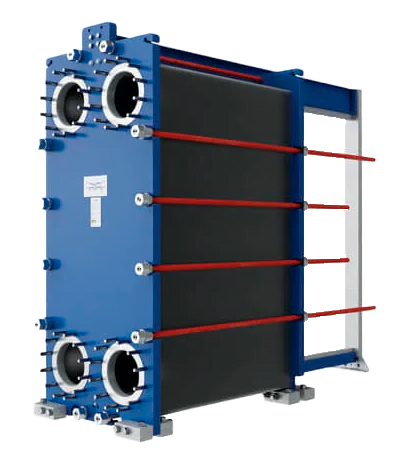Constant comfort temperature with
Heat exchangers
Plate heat exchangers are capable of consistently maintaining the "comfort zone" with excellent heat transfer efficiency and reliability in liquid-to-liquid or vapor-to-liquid applications. In addition, they conserve space and are lightweight and affordable.
One consists of multiple thin, slightly separated plates that have very large surface areas and fluid flow passages for heat transfer.
This stacked plate arrangement can be more efficient, in a given space, than the shell and tube heat exchanger. Advances in gasket and welding technology have made the plate heat exchanger increasingly practical.
In HVAC applications, large heat exchangers of this type are referred to as plate and frame heat exchangers; when used in open circuits, these heat exchangers are usually of the gasketed type to allow for periodic disassembly, cleaning and inspection.

There are many types of permanently bonded plate heat exchangers, such as brazed and vacuum brazed immersion plate varieties, and they are often specified in closed loop for applications such as refrigeration. Plate heat exchangers also differ in the types of plates used and the configurations of those plates. Some plates may be marked with "chevron" or other patterns, while others may have machined fins and/or slots.
Shell and tube exchanger
Shell and tube heat exchangers consist of a series of tubes. One set of these tubes contains the fluid to be heated or cooled. The second fluid runs over the tubes that are being heated or cooled so that it can provide the heat or absorb the heat needed.
A tube bundle is called the tube bundle and can be composed of various types of tubes: plain, longitudinally finned, etc. Shell and tube heat exchangers are typically used for high pressure applications (with pressures above 30 bar and temperatures above 260°C). This is because shell and tube heat exchangers are robust due to their shape.
Plate and finned exchanger
This type of heat exchanger utilizes "sandwich" passages containing fins to increase the effectiveness of the unit. Designs include cross-flow and counter-flow, along with fin configurations of various shapes, such as straight fins, offset fins and wavy fins.
Plate heat exchangers and heat fin are generally made of aluminum alloys that provide higher heat transfer efficiency. The material allows the system to operate at a lower temperature and reduce the weight of the equipment. Plate and fin heat exchangers are mostly used for low temperature services such as natural gas, helium and oxygen liquefaction plants, air separation plants and transportation industries such as engine and aircraft engines.

